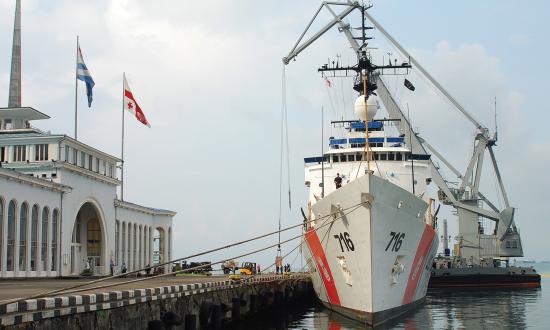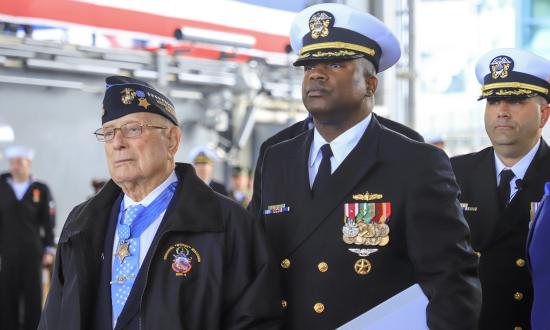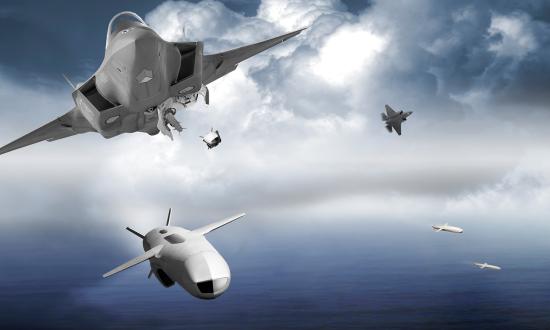The Sea Services understand that the next war probably will be won by whichever side best denies use of the electromagnetic (EM) spectrum to the other—and potential adversaries understand this, too. At present, communication, navigation, and targeting all depend primarily (often exclusively) on radio-frequency (RF) transmission, a precarious dependency given the variety of techniques available to intercept or disrupt it. To find alternatives, researchers at the Naval Research Laboratory (NRL) are turning to one of the oldest naval communication technologies to reclaim the communications high ground: lights.
Until recently, lights had only limited information-carrying capacity. Every modern sailor knows “red right return”—keep the red light of the buoy to the ship’s starboard in a channel. Since the Age of Sail, colored skyrockets and lanterns at mastheads have been used, but only to share information from short prearranged lists of signals. In the 20th century, ships used Aldis (shuttered) lamps to transmit Morse code, increasing the amount of shareable information by many orders of magnitude, but only at the rate a skilled operator could flip a shutter—a character or so per second. Today, secure, jam-resistant, and high-throughput emitters—incomprehensibly superior, with speeds dwarfing those of 5G wireless—are becoming available.
For short-range communications, “light fidelity” (Li-Fi)—an LED-light-based system that modulates LED’s natural flicker to emulate the shutter lamp system of old— is in testing, but with a “shutter” rate of trillions of times per second, allowing data throughput more than ten times faster than 5G.1
Other solutions show promise as well. In 2017, researchers at Navy, Army, and Air Force research centers received a $45 million Department of Defense grant to develop “free-space optical communications and optical time sharing”—a formal way to say “laser communications.” In a 2017 video interview with Defense & Aerospace Report’s Vago Muradian, NRL’s chief optical communications engineer Linda Thomas said that lasers have the potential “to bring alternative communications channel to the . . . warfighter.”2
“We are looking at taking some of the [commercial] technologies that actually have been fielded,” Thomas said, “and incorporating advanced components, detectors, and receivers to be able to transition them to the operational warfighting regime.”
And not just voice or data communication. Positioning, navigation, and timing (PNT) systems depend on extremely precise time measurement—measuring to the femtosecond how long signals from multiple emitters take to reach a receiver. (A femtosecond is 10-15 seconds—one millionth of a billionth of a second.) “Free space optical time sharing” transmits these time signals with lasers instead of radio waves, creating a light-based system to function as a GPS adjunct, or even as an alternative when adversaries spoof or jam GPS signals or incapacitate the satellites.
A 2019 paper in the journal Nature Communications explains some of the difficulties in using lasers for PNT.3 The authors write that, without help, the motion of both transmitter and receiver means “simple one-way or standard two-way time transfer between flying clocks [could] completely break down” thanks to Doppler shift.
Optical transmissions are subject to more problems than RF ones, because weather can degrade the quality of a light signal much more readily than an RF one. And maintaining line of sight is an absolute requirement for optical communications, while the troposphere—the lower region of the atmosphere where most human activity takes place—can refract (bend) radio signals beyond the horizon. Satellites, balloons, and aircraft can relay lasers, increasing their effective range, but every moving object in the chain creates challenges.
NRL’s Thomas notes a variety of problems. “We have to overcome the atmospheric channel itself,” she says, “as well as have closed-loop pointing acquisition-and-tracking techniques” to allow laser emitters and receivers on ships and aircraft to point directly at each other.
On the other hand, optical communications are much less vulnerable to jamming or spoofing than RF ones. Thomas again: “Optical communication has a very narrow directional beam, so it’s . . . much more jam resistant” than RF. It is also much more difficult to detect or intercept.
distortions caused by Doppler shift.
ESO.org
The Nature Communications paper proposes using a “frequency comb”—a laser whose spectrum is a set of precisely spaced lines, resembling the teeth of a comb—to solve some of the problems. The math is complicated, but essentially, knowing with high precision the spacing of the transmission allows the receiver to correct for errors and synchronize time information to the femtosecond.
Thomas said in 2017 she expected to see workable prototypes in the hands of warfighters in 2020. NRL has been fairly quiet about advances in free-space optics since late 2018, but sooner or later, the Navy and Marine Corps expect to field novel tools to reduce their dependence on satellites and easily detected and jammed RF communication and PNT.
The USS Delbert D. Black (DDG-119) Commissioned in September
The Navy commissioned its newest Arleigh Burke–class guided-missile destroyer, the USS Delbert D. Black (DDG-119) in a private ceremony in Port Canaveral, Florida, on 26 September 2020. As has become the 2020 norm, the commissioning was held without public ceremony because of social distancing rules adopted in response to the novel coronavirus.
The Block IIA destroyer is named for the first Master Chief Petty Officer of the Navy (MCPON), who became senior enlisted advisor to the Chief of Naval Operations in 1967. MCPON Black enlisted in the Navy prior to World War II and was on board the USS Maryland (BB-46) in Pearl Harbor on 7 December 1941 when the Imperial Japanese Navy attacked.
MCPON Black’s widow, Mrs. Ima J. Black, was the ship’s sponsor. She was a sailor as well, having served in the Navy WAVES (Women Accepted for Volunteer Emergency Service) during World War II. Along with Mrs. Black, Secretary of the Navy Kenneth J. Braithwaite and current MCPON Russell L. Smith spoke at the commissioning.
The ship was laid down by Huntington Ingalls Industries in Pascagoula, Mississippi, in June 2016 and launched in September 2017. She will be homeported in Mayport, Florida.
1. LTJG Philip Lowry III, USN, and 2LT Matt Suarez, USMC, “Li-Fi Could Light Up the Dark Battlefield,” U.S. Naval Institute Proceedings, November 2019.
2. Defense & Aerospace Report, interview with Dr. Linda Thomas, 22 August 2017, www.youtube.com/watch?v=s4meEIUIB28.
3. Hugo Bergeron, et al., “Femtosecond Time Synchronization of Optical Clocks off of a Flying Quadcopter,” Nature Communications, 10, article 1819 (2019).









